IC 741 Op Amp: Pin Diagram, Working & Equivalents
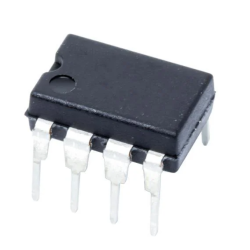
What is LM741 Op-amp IC?
The LM741 chip is a classic operational amplifier integrated circuit (OP-AMP) chip, which has a wide range of applications. It was introduced by Texas Instruments in 1968 and is still widely used today. The 741 chip is loved by engineers and electronics enthusiasts for its stability, reliability and high gain. This chip plays important functions such as amplification, filtering and signal processing in various electronic devices.
LM741 Pinout
The LM741 consists of eight pins. Two pins are used for power supplies, such as Vcc- and Vcc+. The number 741 in the name indicates that there are 7 active pins, 4 pins (pins 2, 3, 4, 7) are able to accept input, and 1 pin (pin 6) is the output pin. The functions and introduction of each pin are as follows:
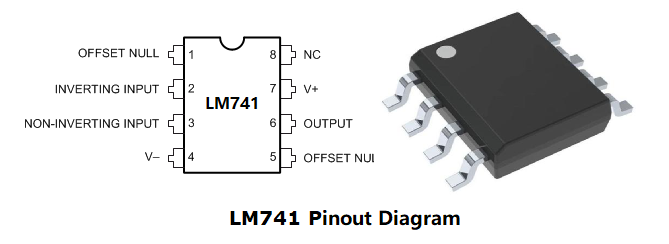
1. Offset Null: Adjusts the offset voltage to zero.
2. Inverting Input (-): Receives the input signal that is 180 degrees out of phase with the output.
3. Non-Inverting Input (+): Receives the input signal in phase with the output.
4. V- (Ground): The negative power supply terminal.
5. Offset Null: Another pin to adjust the offset voltage.
6. Output: The amplified signal is outputted here.
7. V+: The positive power supply terminal.
8. NC (No Connection): Not connected internally, can be used for stabilization if required.
IC 741 Op-Amp Symbol
The symbol for the IC 741 op-amp is straightforward. It includes the inverting and non-inverting inputs, the output, and the power supply connections. The LM741 can operate at single or dual supply voltages.
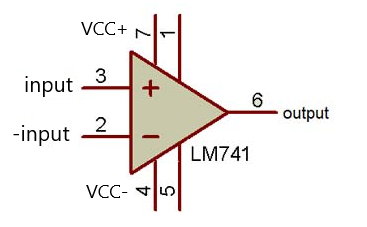
LM741 circuit uses internal compensation, its circuit is relatively simple, not easy to self-excitation. Its operation is stable and simple, and a perfect protection circuit is designed, which is not easy to damage.
Due to its high quality and reliable performance, the operational amplifier LM741 is ideal for comparators, multivibrators, DC amplifiers, summing amplifiers, integrators or differentiators, and active filters.
LM741 Circuit Diagram
Implementing the LM741 in a circuit is simple due to its versatile design. One common configuration is the inverting amplifier, where the input signal is fed into the inverting input. The non-inverting input is grounded, and the feedback resistor sets the gain. The triangle in the IC represents the operational amplifier integrated circuit. Here is the circuit diagram of the LM741.

Features & Specifications
One of the main features of the LM741 operational amplifier is overload protection. Most importantly, it supports overload protection for both antiphase and in-phase pins. Unlike other operational amplifiers, it has the following characteristics:
l No latching circuit requirements
l Immunity from oscillation
l Available in PDIP, CDIP and TO99 packages
Specifications of LM741 operational amplifier
l The input impedance is greater than 100KΩ.
l The output impedance is less than 100Ω.
l The frequency range is between 0HZ and 1MZ.
l Low offset voltage and current.
l The voltage gain is approximately 2,00,000.
l Power supply: In order to work properly, it requires a power supply of at least 5V and can handle voltages up to 18V.
l Input impedance: about 2 MΩ.
l Output impedance: about 75 Ω.
l Voltage gain: Minimum frequency range 2,00,000.
l Conversion rate (the rate at which the operational amplifier can detect voltage changes) : 0.5V/µs.
l Input offset: In the range of 2mV-6mV.
l Output load: greater than 2KΩ is recommended.
l Maximum output current: 20 mA.
Please be noted that:
In order for an op amp to be used as a voltage amplifier, high input impedance and low output impedance values are recommended.
Waveforms for LM741 Noninverting Amplifier Circuit
The waveforms as below show the input and output signals of the LM741 non-inverting amplifier circuit. The blue waveform (top) shows the input signal, while the red waveform (bottom) shows the output signal.
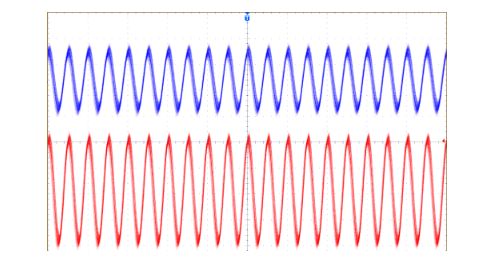
LM741 Equivalents
There are several equivalents to the LM741 op-amp, including:
LM324
Quad op-amp, similar characteristics and applications, lower power consumption.
LM358
Dual op-amp, compatible with single supply operation, suitable for battery-operated devices.
TL071
Low-noise op-amp, improved performance in audio applications, higher input impedance.
TL081
Similar to TL071 but with slightly different specifications. Suitable for general-purpose applications, low noise and high input impedance.
LM1458
Dual op-amp, similar voltage and current characteristics, widely used in analog signal processing.
µA741
Almost identical to the LM741, widely used in academic and industrial applications. Similar pin configuration and electrical characteristics.
OP07
Precision op-amp, low offset voltage and drift, higher accuracy and stability.
OPA2134
High-performance audio op-amp, low noise and distortion, suitable for high-fidelity audio applications.
When choosing a replacement for the integrated circuit 741, it should be evaluated according to the specific application needs and design requirements. Different alternatives may vary in terms of performance, power consumption, price, and availability. Therefore, when choosing alternatives, factors such as performance requirements, cost effectiveness and availability need to be considered comprehensively.
How does an IC 741 work?
The IC 741 op-amp operates on the principle of negative feedback. This concept involves feeding a portion of the output signal back to the inverting input terminal through an external resistor network. The feedback signal opposes the input signal, creating a linear and active mode of operation rather than switching fully on or off, as in a comparator mode.
Negative feedback is crucial for controlling the gain and stability of the op-amp. The degree of feedback depends on the ratio of two resistors: the feedback resistor (Rf) and the input resistor (Rin). The feedback resistor connects the output to the inverting input, while the input resistor connects the input source to the inverting input. The non-inverting input is typically grounded or connected to a reference voltage.
Feedback Resistor (Rf): Between the output and the inverting input.
Input Resistor (Rin): Between the input source and the inverting input.
Non-Inverting Input: Connected to the ground or a reference voltage.
Here's a basic configuration of an IC 741 op-amp with negative feedback.
Calculating Closed-Loop Gain
The negative feedback reduces the effective gain of the op-amp by a factor of 1 + Rf/Rin. This is known as the feedback factor or closed-loop gain. You can adjust the closed-loop gain by changing the values of Rf and Rin. For example:
l If Rf=Rin, the closed-loop gain is 2.
l If Rf=10 x Rin, the closed-loop gain is 11.
l If Rf=0, the closed-loop gain is 1, meaning the output voltage equals the input voltage.
The following figure shows the basic operations of the LM741. If the input voltage at the in-phase input end, the output end will get the same polarity of the amplified output; If you input the same voltage signal at the inverting input, you will get the same amplification but opposite polarity signal output at the output.
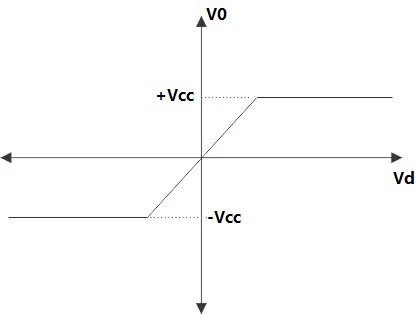
When a voltage is applied to both inputs of the amplifier at the same time, the voltage at the inverting input (V2) is subtracted from the voltage value at the in-phase input (V1) to obtain the ratio of the output multiplied by the output (V1-v2).
What are Advantages of LM741 IC?
One of the main advantages of the LM741 is its reliability. It has been a staple in electronic circuits for decades due to its consistent performance. Its ease of use and availability make it a go-to component for many designers. Additionally, it offers some other important advantages in the circuits.
1. Wide supply voltage range
2. High input impedance
3. Low output impedance
4. Stable performance
5. Short circuit protection
6. Low cost and availability
7. Ease of use
8. High gain bandwidth product
9. Noise reduction
LM741 Package Types
The LM741 has three types of packages, they are:
l DIP (Dual Inline Package)
l SOIC (Small Outline IC)
l TO-99 Metal Can
LM741 Op-Amp Applications
IC LM741 has a very wide range of applications, like variable audio oscillator, this including but not limited to the adjustable ripple RPS four channel audio mixing, automatic light-operated switch, dc voltage polarity meter and so on.
Variable audio oscillator
Using the characteristics of IC 741 operational amplifier, can be built variable audio oscillator, used to generate signals of different frequencies.
Adjustable ripple RPS
By the application of IC 741 operational amplifier, can realize the adjustment of ripple voltage, used in power management and other fields.
Four-channel audio mixing
Using the addition characteristic of IC 741 operational amplifier, can be mixed together multiple audio signals, to realize the synchronous output of multiple signals.
Automatic light control switch
Based on the combination of IC 741 operational amplifier and photoresistor (LDR) , can be made to automatically adjust the brightness of the light control switch.
DC polarity meter
Using the comparative function of the IC 741 operational amplifier, can measure the polarity of the DC voltage.
Electronic room thermometer
By the application of IC 741 operational amplifier, can be made of electronic thermometer, to achieve accurate temperature measurement and display.
Microphone amplifier
Using the gain characteristics of IC 741 operational amplifier, can amplify the sound signal collected by the microphone, improve the quality of the signal.
Thermal contact switch
Through the temperature detection function of IC 741 operational amplifier, can realize the temperature control switching circuit.
Wind generation
Using IC 741 operational amplifier to build the circuit, can simulate and generate various wind effects.
Short-circuit RPS protection
Through the monitoring function of IC 741 operational amplifier, to achieve short-circuit protection, improve the safety and stability of the circuit.
How do I know if my IC 741 is working?
To determine if your IC 741 operational amplifier (op-amp) is working correctly, you can try to follow these steps:
1. Visual Inspection
Start with a visual inspection. Look for any visible physical damage such as cracks, burn marks, or broken pins.
2. Power Supply Check
Next, use a multimeter to measure the voltage at the V+ and V- pins of the IC. The voltage should be within the specified range, typically ±5V to ±15V. Also, verify that the ground connection is correct.
3. Basic Functionality Test
For a basic functionality test, apply a known voltage to the non-inverting input (pin 3) and ground the inverting input (pin 2). Measure the output voltage (pin 6). The output voltage should be close to the input voltage, indicating the IC is functioning.
4. Offset Voltage Test
Connect both the inverting input (pin 2) and the non-inverting input (pin 3) to ground. Measure the output voltage (pin 6). A small offset voltage (typically a few millivolts) is normal. A significantly higher offset indicates a problem.
5. Gain Test
Configure the IC 741 in a known gain configuration, such as a non-inverting amplifier with a gain of 10. Apply a small AC input signal and measure the output. Verify that the gain matches the expected value.
6. Frequency Response Test
Apply a sine wave input signal and sweep the frequency from low to high. Use an oscilloscope to observe the output signal. The IC should maintain consistent gain up to its specified bandwidth, typically 1 MHz for the LM741.
By following these checks and tests, you can verify whether if your IC 741 op-amp is working correctly. If the IC passes these tests, it is likely functioning as expected. If any test indicates an issue, you may need to replace the IC or check the surrounding components and connections in your circuit.
Precautions for Using LM741
When using the LM741 operational amplifier, it's crucial to follow certain precautions to ensure optimal performance and longevity.
Proper Power Supply
Ensure the supply voltage is within the specified range of ±5V to ±15V. Using a stable and clean power supply helps avoid introducing noise and fluctuations that could affect the op-amp's performance.
Avoid Overloading
Do not exceed the maximum input voltage and output current ratings. The input voltage should not go beyond the supply voltage, and the output current should stay within the IC’s safe operating limits.
Proper Heat Management
Although the LM741 typically does not generate significant heat, adequate ventilation and considering heat sinks in high-power applications are important to avoid thermal issues.
Bypass Capacitors
Place bypass capacitors (typically 0.1µF and 10µF) close to the power supply pins to filter out noise and provide a stable supply voltage.
Grounding
Ensure all parts of your circuit share a common ground reference to avoid ground loops that can introduce noise and instability. Proper grounding techniques minimize noise and ensure stable operation.
Input Protection
Use clamp diodes at the input to protect against voltage spikes exceeding the input voltage limits. Adding small series resistors to the input can limit current and protect the input stage of the op-amp.
Proper Feedback Configuration
Use appropriate values for feedback resistors to set the desired gain and ensure stable operation. Minimize capacitive loading at the output, as it can cause oscillations. If unavoidable, use a compensation capacitor to stabilize the circuit.
Temperature Considerations
Ensure the operating temperature remains within the specified range (0°C to 70°C). Extreme temperatures can affect performance and longevity.
What is the Difference Between IC 555 and IC 741?
The IC 555 is primarily used for timing, pulse generation, and oscillator applications, while the IC 741 is an operational amplifier used for signal amplification and analog computation. Below table shows their key differences in every aspect.
|
Feature |
IC 555 Timer |
IC 741 Op-Amp |
|
Function |
Timer, oscillator, and pulse generator |
Operational amplifier (op-amp) |
|
Primary Use |
Timing applications, PWM, astable and monostable multivibrators |
Signal amplification, filtering, and analog computation |
|
Supply Voltage Range |
4.5V to 15V |
±5V to ±15V |
|
Output Type |
Digital (high or low) |
Analog |
|
Number of Pins |
8 |
8 |
|
Pin Configuration |
VCC, GND, Trigger, Output, Reset, Control Voltage, Threshold, Discharge |
Offset Null (2), Inverting Input (-), Non-Inverting Input (+), V-, Output, V+, No Connection (NC) |
|
Frequency Range |
Up to 500 kHz |
Typically up to 1 MHz |
|
Operating Temperature |
0°C to 70°C |
0°C to 70°C |
|
Applications |
LED flashers, pulse generation, tone generation, clock pulse generation |
Audio amplifiers, active filters, signal conditioning, analog computation |
|
Typical Output Current |
200 mA |
20 mA |
|
Internal Configuration |
Comparators, flip-flop, discharge transistor |
Differential input stage, voltage gain stage, output stage |
|
Gain |
N/A |
Open-loop gain typically 200,000 |
|
Input Impedance |
N/A |
Typically 2 MΩ |
|
Output Impedance |
Low |
Typically 75 Ω |
|
Special Features |
Adjustable duty cycle, stable and accurate timing |
High input impedance, short circuit protection, low offset voltage |
The LM741 op-amp remains a popular choice for many electronic applications due to its versatility, reliability, and ease of use. Its ability to amplify signals accurately and its wide range of applications make it a valuable component in any engineer's toolkit. When designing circuits, understanding the pinout, features, and precautions ensures optimal performance and longevity of the LM741.
Related Content:
1. Op Amp IC 741 Basics, Characteristics, Pins & Applications
2. IC 7408 Equivalents: Datasheet and Pinout
3. IC 7408 Logic Gate Chip: Pin Diagram and Truth Table
Statement
All articles (images, texts, audio) on this site are uploaded and shared by users, or
integrated from relevant internet sources, only for user's learning. If your rights are
violated, please contact the administrator to delete! Link to this article:







